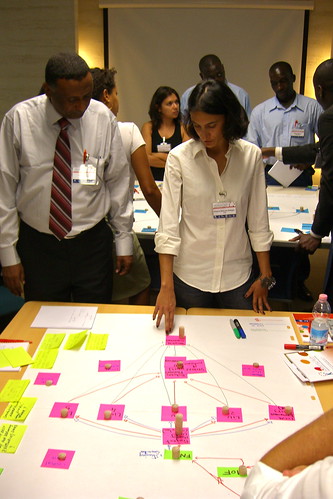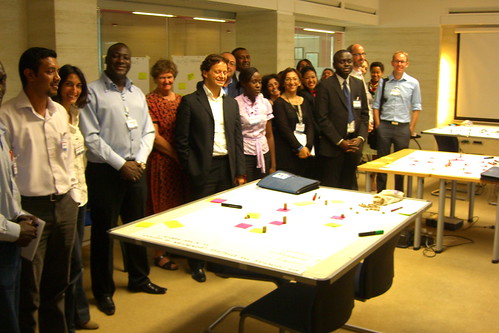post and images by Paolo Brunello.
The promises of Net-map appeal to many judging from the number of people who attended this workshop: indeed everyone admitted to have felt puzzled by complexity, overwhelmed by it, so when you propose a method to harness that complexity instead of succumbing to it, people respond.
In fact Net-Map is a technique that allows for zooming out of our own little clearance of knowledge and hover above it, so that we can grasp the wider context and make sense of it.We started with a "stone in the pond". It's a quick and effective technique to get a feeling of the group and it works like this: people stand in the middle of the room and who feels like it starts off by saying something along the line of: "Hi, I'm Judith, I work in farmers empowerment in Ghana and what I would like to get out of this session is a method to help me engage them more effectively". Everyone will then move, standing very close to Judith if they share her expectation or further away if they don't, along a continuum, like waves of a pond when a stone is thrown in the middle. Thus in few minutes we realised that there was a common interest in learning Net-Map both for strategic planning and monitoring and evaluation, in other words both to create a shared vision of the situation in order to optimise coordinated action and also to visualise the state of things at different times during a process, thus allowing for pre-post comparison. Almost everyone was new to Net-map so the challenge to learn it in such a short time was big. After a short introduction to the basic steps of the method, three subgroups were created and started to work right away on their maps: they first chose a case study and identified the core question: "Who influences the success of...." and then started writing the names of all the different stakeholders on post-it notes to be placed on the map. Then they selected some relevant links connecting the different stakeholders, like money flow - who is paying whom? - or training - who is training whom? - and they drawn these links using different colors. Then they started assessing the relative influence of each actor in answering that original question, using some wooden discs to build "influence towers" besides each actor.
The final result was a map that portrayed the perceived distribution of power in the system under exam. But perhaps even more important was the process that lead to that map, since every member of the group had to explain why they thougth a certain actor was more - or less - influential, thus making their premises explicit. This in one of the key feature of Net-Map: having to draw together, net-mappers are "forced" to share their implicit knowledge of the system under exam making it visible to others, so that we assist to a mutual "perception tuning" that can greatly help the coordination of any subsequent action. While the exercise was going on, some participants voluteered to take an observer's role, to focus on the process of net-mapping without being caught into the specific details of the case study. This then allowed the trainers to address the most burning questions in the final plenary discussion.Finally, as an evaluation, we asked the participants to line up according to their degree of willingness to use Net-Map in the near future and we were pleased to see that the majority of them were optimistic in trying it out in their context.
The promises of Net-map appeal to many judging from the number of people who attended this workshop: indeed everyone admitted to have felt puzzled by complexity, overwhelmed by it, so when you propose a method to harness that complexity instead of succumbing to it, people respond.
In fact Net-Map is a technique that allows for zooming out of our own little clearance of knowledge and hover above it, so that we can grasp the wider context and make sense of it.We started with a "stone in the pond". It's a quick and effective technique to get a feeling of the group and it works like this: people stand in the middle of the room and who feels like it starts off by saying something along the line of: "Hi, I'm Judith, I work in farmers empowerment in Ghana and what I would like to get out of this session is a method to help me engage them more effectively". Everyone will then move, standing very close to Judith if they share her expectation or further away if they don't, along a continuum, like waves of a pond when a stone is thrown in the middle. Thus in few minutes we realised that there was a common interest in learning Net-Map both for strategic planning and monitoring and evaluation, in other words both to create a shared vision of the situation in order to optimise coordinated action and also to visualise the state of things at different times during a process, thus allowing for pre-post comparison. Almost everyone was new to Net-map so the challenge to learn it in such a short time was big. After a short introduction to the basic steps of the method, three subgroups were created and started to work right away on their maps: they first chose a case study and identified the core question: "Who influences the success of...." and then started writing the names of all the different stakeholders on post-it notes to be placed on the map. Then they selected some relevant links connecting the different stakeholders, like money flow - who is paying whom? - or training - who is training whom? - and they drawn these links using different colors. Then they started assessing the relative influence of each actor in answering that original question, using some wooden discs to build "influence towers" besides each actor.
The final result was a map that portrayed the perceived distribution of power in the system under exam. But perhaps even more important was the process that lead to that map, since every member of the group had to explain why they thougth a certain actor was more - or less - influential, thus making their premises explicit. This in one of the key feature of Net-Map: having to draw together, net-mappers are "forced" to share their implicit knowledge of the system under exam making it visible to others, so that we assist to a mutual "perception tuning" that can greatly help the coordination of any subsequent action. While the exercise was going on, some participants voluteered to take an observer's role, to focus on the process of net-mapping without being caught into the specific details of the case study. This then allowed the trainers to address the most burning questions in the final plenary discussion.Finally, as an evaluation, we asked the participants to line up according to their degree of willingness to use Net-Map in the near future and we were pleased to see that the majority of them were optimistic in trying it out in their context.




For more info on Net-Map, you can visit http://netmap.wordpress.com or come to session 177 at 16:00 in C400 on Tue the 27th
ReplyDelete